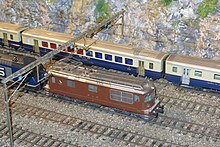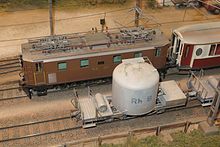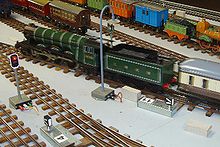Nominal size 0
The nominal size 0 (spoken: nominal size zero), also common in England and North America under the term 7 mm scale , is one of the standards of European model railways (NEM), the standards of the British Railway Modeling Standards Bureau (BRMSB) and the standards of the National Model Railroad Association (NMRA) specified size for model railways . The standard gauge with a prototype gauge of 1435 mm has a model gauge of 32 mm and is colloquially referred to as gauge 0. Historically, the scale differs in the various regions: in continental Europe it is usually 1:45, in England and France 1: 43.5 and in North America 1:48.
history
Development of the market position
The nominal size 0 for model railways was introduced at the beginning of the 20th century. It replaced the nominal size I as the most commonly used size, because the space requirement was lower and the models became cheaper (also thanks to the emerging industrial mass production). The nominal size 0 thus became the second dominant nominal size in model railway history. In the 1950s and 1960s it was replaced by the nominal size H0 from this role.
Market position today
In Europe today, models of nominal size 0 are mainly to be found at model railroad builders and in exhibitions, for example as vehicle models in museums, as dioramas, modular or club systems. More recently, the scale has also found a certain spread among fans of historical models, which are mainly made of tinplate . Models and accessories are still being manufactured, be it as replicas or as new designs.
The nominal size 0 is also widespread in the USA and Canada.
From 2007 Lenz Elektronik began to manufacture 0-gauge tracks and vehicle models based on German models in large-scale production. This triggered a renaissance of the 0 gauge in Germany. Well-known manufacturers have been added in the past few years: Brawa, Busch, MBW, Viessmann and others. Its popularity and market share have grown. You can find 0 gauge models in more and more model railway shops; The trade press is also increasingly bringing articles about 0. Gauge 0 has now developed a niche market next to Gauge 1 again in Germany, where the position compared to other nations was weak for decades due to the spread of Gauge 1 (Märklin).
Gauges
Continental Europe
The following model gauges are specified for the scale 1: 43.5 and 1:45 in the European Model Railways (NEM) standards:
| track | designation | Model gauge | Prototype gauge (selection) | Use of the prototype gauges |
|---|---|---|---|---|
| 0 | Standard gauge | 32 mm | 1435 mm | from 1250 mm to 1700 mm |
| 0m | Meter gauge | 22.2 and 22.5 mm | 1000 mm | from 850 mm to <1250 mm |
| 0e | Narrow gauge | 16.5 mm | 750 mm, 760 mm and 800 mm | from 650 mm to <850 mm |
| 0i (0f) | Field railway | 12 mm | 500 mm and 600 mm | from 400 mm to <650 mm |
| 0p | Park lane | 9 mm | 381 mm | from 300 mm to <400 mm |
Great Britain
The following model gauges are specified for the scale 1: 43.5 in the British Railway Modeling Standards Bureau (BRMSB):
| track | designation | Model gauge | Prototype gauge |
|---|---|---|---|
| 0 | Standard gauge | 32 mm | 1435 mm (4 feet 8½ inches ) |
| 0-22.5 | Cape Track | 22.5 mm | 1067 mm (3½ feet) |
| 0-18 | Narrow gauge | 18 mm | 762 mm (2½ feet) |
| 0-16.5 | Narrow gauge | 16.5 mm | 686 mm and 711 mm (2¼ and 2⅓ feet) |
| 0-14 | Narrow gauge | 14 mm | 610 mm (2 feet) |
North America
The National Model Railroad Association (NMRA) established the following 1:48 scale gauges :
| track | designation | Model gauge | Prototype gauge |
|---|---|---|---|
| 0 | Standard gauge | 32 mm | 1435 mm (4 feet 8½ inches ) |
| 0n3 | Narrow gauge | 19.1 mm | 914 mm (3 feet) |
| 0n30 (0n2½) | Narrow gauge | 16.5 mm | 762 mm (2½ feet or 30 inches) |
| 0n2 | Narrow gauge | 12.7 mm | 610 mm (2 feet) |
Track systems of gauge 0
Main article: H0 gauge track systems
Similar to the H0 gauge, there are now three electrical track systems for the 0 gauge : the two-rail, three-rail and central-rail system. Here, too, the two-conductor track system and the central conductor system are predominantly used today, with alternating or direct current, and increasingly also in digital operation. When operating with clockwork motors and steam, tracks that are not electrically separated or tracks made of plastic can be used.
Lionel has a certain market position in North America . To this day, the center conductor is formed by a third continuous rail.
In order to be able to operate models of different electrical constructions on one layout, a switchable three-wire track system is sometimes used.
Comparatively coarse rail systems from the companies MTH and Atlas from the USA are common. Closer to the prototype and just as widespread are the tracks made by the British company Peco with a replica of English small iron. In the German-speaking countries, the Lenz track system has become popular for home and modular systems in recent years. In addition, numerous small series manufacturers offer do-it-yourself tracks and points with wooden sleepers that are very true to the original.
Scale deviations
Historically, the standards for the nominal size 0 are different. The scale in the countries of continental Europe is 1:45 (calculated from the track of the prototype 1435 mm divided by the 32 mm of the model track width). In Great Britain the scale 1: 43.5 is common, calculated from 7 mm in the model corresponds to one foot (304.8 mm) of the prototype. In North America, a scale of 1:48 is common, calculated from 1/4 inch (6.35 mm) in the model corresponds to one foot (304.8 mm) of the original.
Of course, the models based on the same prototypes on a scale of 1: 43.5 appear more massive than those on a scale of 1:45 or 1:48.
The importance of model cars in the widespread 1:43 scale is also significant today with the nominal size 0. The 1:50 scale, in which mainly trucks and construction vehicles are available, also fits the 1:48 rail models.
Manufacturer
0-gauge models and accessories were mainly manufactured in Germany before the Second World War by Märklin , Bing , Kraus Fandor and Karl Bub ; from 1946 Konrad Dressler also offered simple models. In 1949 Fleischmann was added, who, as a major innovation, dispensed with the center conductor and, in contrast to Märklin, offered far fewer locomotives with clockwork drives. In Switzerland, Buco and HAG were well-known manufacturers in the 0 gauge. Models and accessories in the 0 gauge were manufactured by the metal goods factory Stadtilm and Zeuke & Wegwerth in the GDR .
Because of the ever-improving detailing and quality of the vehicles of nominal size H0 and the resulting significantly smaller space requirement, the 0 gauge was finally abandoned by Märklin in 1955 and by Fleischmann in 1959.
Lima , Rivarossi and Pola later offered a complete range of rolling stock, track material and accessories for the 0 gauge, with Pola initially focusing on vehicle kits. The Pola molds were used by various manufacturers and some are still used today. Since the detailing corresponded to the Lima and Jouef models for the H0 gauge, which were produced in large numbers from the late 1960s to the early 1990s , the prices were correspondingly low compared to products from small series manufacturers.
Industrially manufactured narrow-gauge models for the 0e gauge were already available in the mid-1930s. First Billerbahn produced corresponding models, then from 1970 to 1972 Märklin sold narrow-gauge models under the name Märklin-Minex, later Fleischmann followed under the name Fleischmann Magic-Train. While Billerbahn offered its own field railway track system, Märklin and Fleischmann sold their narrow-gauge vehicles with their H0 gauge track system, which, at 16.5 mm, has the same model gauge as the 0e gauge.
For a short time in the 1980s and 1990s, the 0m gauge was also popular in the Alpine region after UTZ initiated a complete Alpine railway program at low prices. After the sale of the corresponding product division, combined with the outsourcing of production, the market share fell significantly again.
Today, numerous manufacturers offer rolling stock, track material and accessories for nominal size 0. While Fleischmann has in the meantime given up the production of the Fleischmann Magic-Train vehicles for the gauge 0e, the products from Peco for the gauge 0-16.5 and Bachmann for the gauge 0n30 have become more widespread (both with the model gauge of 16, 5 mm, corresponding to the H0 track).
With regard to the 0 gauge, Brawa and Lenz Elektronik also appeared on the market as large-scale manufacturers with corresponding products in Europe at the end of the 2000s .
Designations
In North America, and partly in England, the letter O is often used instead of the number 0 to denote the nominal size or the gauge . In the USA the term 1/4 inch scale and in Great Britain the term 7 mm gauge is common.
In England the name for the narrow-gauge railways is inconsistent. In this article, the notation is uniformly used as follows: 0 for the nominal size, minus sign for separating the model gauge, comma as a separator for the decimal point in the number of the model gauge. Example: 0-16.5 .
literature
- Volker Kutschera: Small train on a long journey: 0-gauge toy trains . Edition Ellert & Richter, Hamburg 1996, ISBN 3-89234-684-4 .
Web links
- International working group for model railway construction of gauge 0 - working group (association) and publisher of a German-language magazine for nominal size 0
- Gauge Null Magazin - German-language magazine for nominal size 0
- Online catalog and encyclopedia all about the old 0 gauge from Märklin from Göppingen
Individual evidence
- ↑ All manufacturers of 0m tracks and the Fremo standards use the 22.2 mm gauge for 0m, which results from the 1:45 scale.
- ↑ www.morop.org Norms for European Model Railways, NEM 010, 2011 edition (PDF; 30 kB) Retrieved on October 10, 2012
- ^ Lionel, LCC - Lionel Modelleisenbahn (Brand) on the English language Wikipedia , website of Lionel (model railway manufacturer) and Lionel Fan Page ( Memento from February 25, 2011 in the Internet Archive )









